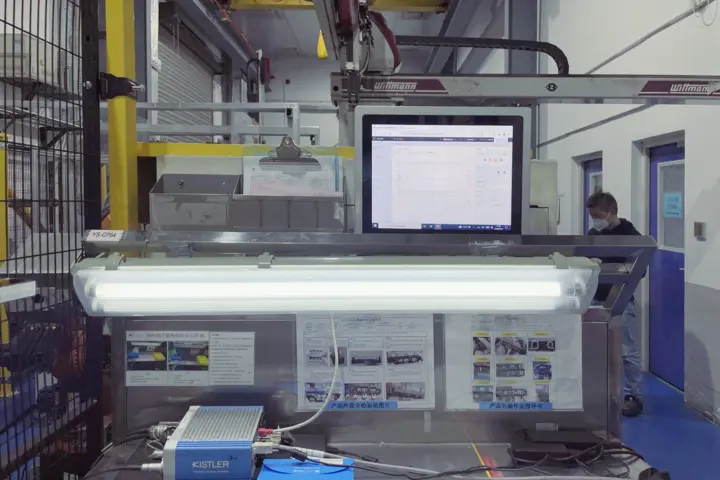Founded in 1836, Schneider Electric SE is a Fortune Global 500 company headquartered in Rueil-Malmaison, France. This renowned multinational electric group has main businesses spanning intelligent power distribution equipment, electrical sockets, and industrial automation control components. With over 120,000 employees worldwide in 2022, Schneider Electric posted revenues of €34 billion from over 100 different locations and areas. Performance in two pillar industries – energy management and industrial automation – was particularly strong, with growth of 10 percent. Present in China since 1987, Schneider Electric now owns 4 R&D centers and 23 plants there with around 17,000 employees countrywide. The company has also taken on a crucial role in the “digital innovation” and “green decarbonization” initiatives advanced by the Chinese government at all levels.
Kistler supports Schneider Electric with process monitoring for innovative injection molding
Intelligent injection molding is a cornerstone of Schneider Electric's worldwide digitalization strategy – and Kistler technology is helping this global giant to ride the trend of Industry 4.0. Measurement and process monitoring solutions from Kistler are key to digitalizing and optimizing Schneider's production processes for challenging electrical components – leading to higher product quality, process stability and transparency across the board.

Real-time monitoring: the key to improvement
Schneider Electric aims to implement an intelligent injection molding approach throughout its globally distributed production operations (as shown in the chart). To achieve this goal, Schneider promotes Kistler technology within the company – specifically, in the form of a one-box package solution that includes cavity pressure sensors and matching data processing/software modules. Schneider Electric China and Kistler launched their collaboration in the second half of 2020, not long after the two companies first made contact. The molding department at Schneider Electric China now truly benefits from this partnership, as they are supported by engineers from Kistler China with technological expertise and constructive suggestions. In this way, many practical problems were solved collaboratively.
Long Shunmao, KIP Technology Leader at Schneider Electric GSC China and an injection molding expert, is responsible for production of the Minitop, a component used in the company's low-voltage electrical distribution products. To ensure high product quality and process reliability, Long combined a scientific molding approach with cavity pressure and temperature sensors as well as a process monitoring system from Kistler. The particular aims here were to understand and control the interrelated changes in five invisible variables during the injection molding process: injection velocity, plastic temperature, plastic pressure, and cooling temperature/time.
“The Minitop products have to meet strict quality criteria for strength, dimensions and service life, among other attributes,” Long notes.
In the initial technology assessment, that’s why we chose side gates for the mold design and polyamide 66 (PA66) – a material with glass fiber content of up to 60% and a 12 mm glass fiber length. But then we had to find a way to make everything work together – and Kistler provided us with the right solution to ensure reliability throughout the entire process.
Long Shunmao, KIP Technology Leader at Schneider Electric GSC China
Higher product quality, less scrap
Four 6182D cavity pressure sensors and two 6195B temperature sensors from Kistler were installed in the mold for quality control and process data visualization. The 6182D sensor is a miniature piezoelectric pressure transducer with a diameter of 2.5 mm, a measuring range of up to 2,000 bar, and a flexible connecting option (single cable or conductive spacer sleeve).
Data provided by the pressure and temperature sensors is visualized and evaluated by the ComoNeo process monitoring system, which delivers real-time curves throughout the injection molding process. As was expected, the combination of submarine gates and a long glass fiber material presented additional challenges for the quality of the molding process, so issues showed up in various aspects of the finished parts such as dimension variation and viscosity.
Consequently, the pressure curves in ComoNeo revealed a mismatch between the submarine gates and the long glass fiber, so melt flow near the gates was often hampered or obstructed. ComoNeo also identified filling imbalances between cavities. Long again: “First, we verified the real cause of the problem; then, as soon as we'd adjusted and defined the quality standards for each process, we were able to boost production performance significantly.” Here are details of the quality control and optimization features of the Kistler process monitoring system that were applied:
- Monitoring and control of mold temperature via sensor signals
- Control of V/P switchover and guarantee of balanced filling (ComoNeoSWITCH)
- Separation of scrap based on defined quality criteria
- Production halt in case of abnormal conditions (e.g. wear, high temperature etc.)
Heading for automated optimization
Holistic process optimization greatly reduced the scrap rate in this application – from 13 to 8 percent overall. Completed parts also undergo X-ray and force testing (clamping, tripping, bending) to ensure consistent quality. And Long already has the next steps in view: “Theoretically, the scrap rate for this challenging component could be lowered to about 1 percent – especially if we make use of the ComoNeoMULTIFLOW feature as well.” This software extension for ComoNeo allows for a cavity pressure-based balancing of the hot runner and therefore automatically compensates material and process fluctuations.
Schneider GSC China's overall goal is to establish a closed-loop interactive control system based on dynamic measurement technologies for injection molding. This implies intelligent and automatic adjustment in a self-adaptive process to guarantee stable product quality without human intervention. Such an outcome would represent level three of intelligent injection molding, involving automatic adjustment of temperature (multiple nozzles), and automatic switchover (V/P) by means of screw position and cavity pressure.
Long Shunmao concludes: “Molding engineers rely on efficient methods to verify various ever-changing combinations of molds, materials, and equipment. With the help of intelligent injection molding solutions and professional consulting services from Kistler, Schneider Electric's production team successfully achieved three key objectives: innovative digitalization of the injection molding process, lower energy consumption, and improved production yield.”






![Global partnership to advance intelligent injection molding [object Object]](https://kistler.cdn.celum.cloud/SAPCommerce_Document_Preview/961-838e.webp)